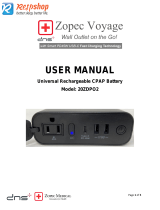
15
Troubleshooting
The table below lists some of the problems you may experience with your humidier and possible solutions.
Problem Why it Happened What to Do
Nothing happens when
you apply power to the
humidier.
Loss of AC/DC power or
the device is unplugged.
Verify that the humidier and therapy device are properly plugged
in. Make sure the AC power cord is connected correctly to the
power supply and the power supply cord is correctly plugged into
the wall.
If the problem continues to occur, contact your home care
provider. Return the humidier, therapy device, and power supply
to your provider to determine if the problem is with the therapy
device, humidier, or power supply.
High Leak The tubing is not
connected correctly and
doesn’t seal properly.
Remove your mask and tubing and check for kinks or tears. If it
is torn or damaged, contact your home care provider or Philips
Respironics for replacement tubing and/or mask.
If the tubing is not damaged, reattach your tubing, turn on the
airow, and check to make sure you do not still feel air coming out
of the port area.
The therapy device is not
seated correctly against
the humidier.
Remove the therapy device from the humidier and reconnect.
Make sure the air inlet port on the humidier connects securely to
the air outlet port on the device.
If high leak persists, issue may be caused by a missing, misaligned or
damaged seal. Ensure that dry box seal and humidier lid seal are
present, in their proper orientation and fully seated. If a seal has
come loose, gently press around the edges of the seal to reseat it.
The humidier tank is not
properly seated in the
humidier.
Remove the water tank from the humidier base, and then place the tank
back in the humidier, making sure it is completely seated.
If high leak persists, issue may be caused by a misaligned or damaged
seal. Ensure that dry box seal and humidier lid seal are in present,
in their proper orientation and fully seated. If a seal has come loose,
gently press around the edges of the seal to reseat it.
The humidier is cracked or
damaged.
The humidier was
dropped or mishandled.
If the humidier does not operate properly after being dropped or
mishandled, contact your home care provider or Philips Respironics.
The therapy device is
operating but the humidier’s
airow is low or stopped.
The humidier has an
airow obstruction.
Contact your home care provider. Return the humidier and power
supply to your provider to determine the problem.
Excessive condensation in
the tubing.
The humidity level setting
is too high.
Reduce the humidity level setting.
The humidier is
positioned incorrectly.
Verify that the humidier and therapy device are away from air
conditioning equipment.
Heated tube is not warming. Heated Tubing setting is
set to zero.
Make sure the Heated Tubing setting is not set to zero. Refer to
your therapy device’s user manual for instructions.
The humidier has fallen off
your table or night stand.
The humidier may not
have been properly seated
on the night stand, or the
placement of the tubing
may have caused the
device to fall.
Always make sure your humidier is placed on a hard, at surface
so the rubber feet on the bottom of the humidier base can adhere
to the surface (make sure there is no fabric under the base). The
humidier must be level for proper operation.
Also, place the humidier away from the edge of the night stand or
table, so it doesn’t accidentally get knocked off the table.
If the humidier falls and water gets into the therapy device, drain all
water out of the therapy device. Allow it to air dry to make sure it
is completely dry before reapplying power.
If the placement of the tubing causes the humidier to fall, make
sure that you use proper hose management when setting up your
device. Route the tubing behind the bed’s headboard.
If the humidier does not operate correctly after falling, contact
your home care provider or Philips Respironics.




















